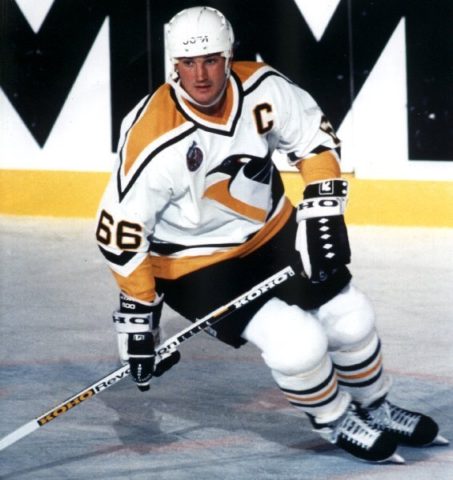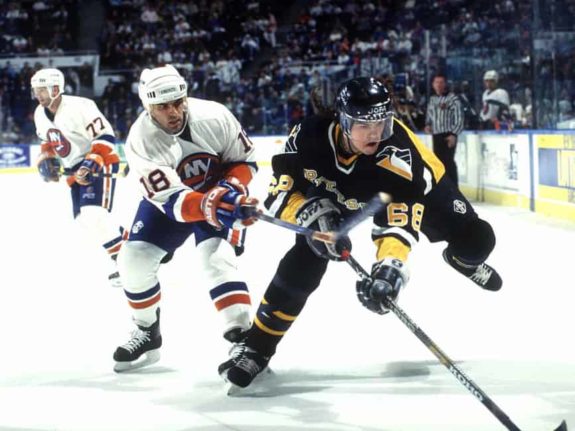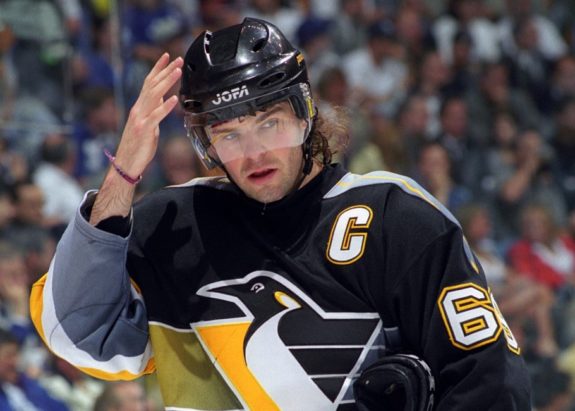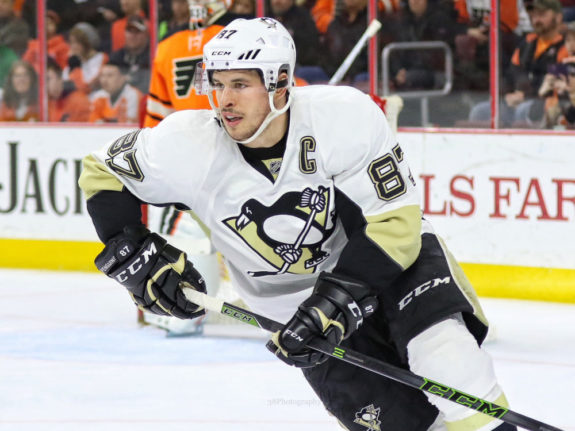The ’12 Days of Christmas’ is a classic holiday song first published in its current form in 1908. In a nod to the classic carol, join The Hockey Writers as we count down the 12 Days of Hockeymas. Each day, we will provide you with a piece of hockey history as we eagerly await the start of the 2020-21 NHL season.
To date, the Pittsburgh Penguins have competed in 52 NHL seasons and hold an all-time record of 1,866-1,718-383-148. With that amount of regular-season wins, there is bound to be some regular-season success. Aside from winning the Stanley Cup five times, they’ve also piled up eight division titles over the years.
To continue celebrating the 12 Days of Hockeymas, let’s run down and take a look back at all eight of the division titles in Penguins’ franchise history. Not listed, however, will be the 2010-11 season when finished in a tie with the Philadelphia Flyers at 106 points. The Flyers edged the Penguins out in a tiebreaker to hold the No. 1 spot in the Atlantic Division that season.
1990-91
In Mario Lemieux’s sixth season, he and Paul Coffey led the Penguins to their first-ever Division Title in 1990-91. A record of 41-33-6 landed them with 88 points and first in the Patrick Division. Overall, their 88 points ranked seventh across the league. While the Penguins have won five Stanley Cup titles, this was the only championship season where they went into the postseason as the divisional leaders.
The 1990-91 season was the only year “Badger” Bob Johnson was the head coach of the Penguins before his untimely death in November of 1991. Johnson previously coached the Calgary Flames to five consecutive playoff appearances, including a Cup Finals berth in 1986. Before the Penguins hired him, Johnson had coached 400 games and had a record of 193-155-52. Many players who were coached by Johnson say that he was the best coach they ever had.
The road to the top of the division was not an easy one for the Penguins. Lemieux only played in 26 games due to back surgery and an infection that threatened his ability to ever walk again, let alone play hockey. With that uncertainty, general manager Craig Patrick made moves to acquire four future Hall of Famers.
Before the season began, five-time Stanley Cup Champion Bryan Trottier signed as a free agent from the New York Islanders. As the season went on, the team made trades to acquire Larry Murphy from the Minnesota North Stars, Joe Mullen from the Flames, and Ron Francis from the Hartford Whalers. Each of these four players would be key to winning back-to-back Cups in 1991 and 1992.
All of the moves and coaching, plus the return of Lemieux, all culminated in the team’s first division title and eventually their first championship.
1992-93
The 1992-93 Penguins team is often considered the best lineup the franchise has ever seen. The group seemed poised to claim their third straight Stanley Cup Championship but fell short in the Divisional Finals. The Pens finished the 1992-93 season with a 56-21-7 record for 119 points and the franchise’s only Presidents’ Trophy.
Despite the impressive numbers, the season was again no cakewalk. Captain Lemieux’s career was again in jeopardy, this time following a diagnosis of Hodgkin’s lymphoma. Radiation treatment forced him to miss 23 games, but he had a large lead in the league scoring race when he left. What kept 66’s motivation up while he was out was watching Buffalo Sabres’ forward Pat LaFontaine. When Lemieux returned, he was trailing LaFontaine by 12 points in the scoring race.

Not only did Lemieux surpass LaFontaine for the scoring title with 160 points, but he did it while picking up 56 in his last 20 games. Those points helped the Penguins set a new NHL record for most consecutive wins, with 17 straight to close out the season, a record that still stands today.
Just because you are the best team doesn’t mean you are going to win it all. The Penguins lost to the New York Islanders in seven games in the Divisional Final Round.
1993-94
For the first time, the Penguins repeated as division champions, but this one may not have happened if the NHL didn’t expand to 26 teams and realign the divisions. Pittsburgh moved to the Northeast Division away from the New York Rangers and New Jersey Devils, who both finished with more points. The Northeast Division also did not have the rival Flyers or Washington Capitals.
The Penguins finished the 1993-94 season with a 44-27-13 record for 101 points. Yet again, however, it wasn’t going to be easy since Lemieux would undergo a second back surgery that limited him to only 22 games that year. Without Lemieux, it was up to Jaromir Jagr to keep the team in the discussion as one of the best in the league.

Jagr grew into one of the best in the game and scored 99 points that season, including 67 assists, which was a career-high at the time. As good as Jagr or the team may have been, the season ended after a six-game series loss to the Washington Capitals in the opening round of the playoffs.
1995-96
Still playing in the Eastern Conference’s Northeast Division away from the Flyers or Rangers, the Penguins took home their fourth division title with a 49-29-4 record and 102 points. Of the Penguins’ 49 wins that season, 12 of them came from game-winning goals by Jagr, who set a franchise record that year for the most in a single season.
Lemieux missed the entire 1994-95 season from his back surgery, but upon return, he ended up on a line with Jagr and Francis. Three players in the top-10 all-time in scoring was near impossible to stop for opposing defensemen. The trio all finished with over 100 points each and were first, second, and fourth in the league in scoring.
The 1995-96 Penguins were more than just their first line, however. That same squad also featured standout performances by Petr Nedved, who scored a career-high 99 points, Sergei Zubov led the team in defensive scoring with 66 points, and goalie Tom Barrasso put up 29 wins.
The team, despite its star power, only made it to the Eastern Conference Finals. In seven games, the Florida Panthers punched their ticket to the Stanley Cup Final.
1997-98
In the season following Lemieux’s first retirement, Jagr and company proved again, even without No. 66, they were one of the top teams in the NHL. A record of 40-24-18 and 98 points was good enough to lead the Northeast Division and finish fourth in the league. While there would still be playoff appearances in the years to follow, this was the last season for a long time they’d lead their division.

At the age of 25, and without Lemieux by his side, Jagr continued his dominance of not only being the Penguins’ best player but also the best in the league. Jagr would win the Art Ross Trophy as the NHL’s top point scorer with 102 points. It was the first of four consecutive Art Ross Trophies to be won by Jagr, the first player to do that since Wayne Gretzky won seven straight from 1981 to 1987.
But Jagr’s greatness just wasn’t enough for the team, as they would go on to lose the opening round of the playoffs to the Montreal Canadiens.
2007-08
The first division title in 10 years for the Penguins, the 2007-08 season, is also the second time the organization would reach the Stanley Cup Final while being a division leader. And it seemed as if they were primed for a Cup victory when they added Marian Hossa and Pascal Dupuis at the trade deadline.
The Penguins would have a phenomenal postseason, losing only twice on their way to reaching the Stanley Cup Final. In the Final, they ran into a Detroit Red Wings’ team stacked with veteran players who helped them win the Presidents’ Trophy. The Red Wings would win the series in six games for their 11th Cup Championship.
Hossa put up the best postseason of his career, scoring 26 points in 20 games, behind only linemate Sidney Crosby and the Red Wings’ Henrik Zetterberg for the playoff lead in points. Hossa was displeased, however, and decided to sign a one-year deal with Detroit because it gave him a “better chance to win the Cup.” The Penguins would beat Detroit in the Cup Final that year.
2012-13
A lockout-shortened the 2012-13 season to just 48 games, so every team had to bring their A-game. The Penguins did just that, posting their best-ever winning percentage in team history. A record of 36-12-0 landed them with 72 points, as they won 75% of their games. Tying the Blackhawks for the most wins on the season, Pens’ fans will remember 2012-13 more for the team they built mid-season.
General manager Ray Shero made moves at the season’s trade deadline to add an unreal amount of skill to the Penguins. Acquiring Jarome Iginla from the Flames, Brendan Morrow from the Dallas Stars, Jussi Jokinen from the Carolina Hurricanes, and Doug Murray from the San Jose Sharks all lent a hand in driving the team to the Eastern Conference Finals.
While the Penguins had plenty of talent, and the wins to back it up, they just couldn’t find the back of the net in the Eastern Conference Finals against the Boston Bruins. The Penguins scored only two goals in the four games, getting shut out twice.
2013-14
Crosby’s first full season following his long bout with a concussion and the 2012-13 lockout, the Penguins were led by their captain to a 51-24-7 record and 109 points to repeat as division champs. The Penguins led the Metropolitan Division by 13 points over the Rangers.
Scoring a league-leading 104 points, Crosby took home the Art Ross and the Hart Memorial Trophy as the league’s most valuable player, which is the last time a Penguin won either award. Much like the seasons before, just because a team or player has great success during the regular season doesn’t mean they are going to succeed in the postseason.

The Rangers would have the last laugh, as the Penguins would blow a 3-1 series lead in the second round that year. It was another year of postseason disappointment by the Penguins, which led to changes. They’d replace Shero with Jim Rutherford, and shortly after that, Rutherford fired head coach Dan Bylsma. Despite back-to-back division titles and being the winningest coach in Penguins history, Bylsma’s lack of playoff success since the 2009 Cup was a key reason for his departure.
The Penguins have proven to be a very successful regular season team. But they’ve learned that early success doesn’t always lead to postseason success. A harsh reality, but one the franchise is all too aware of. They’ve only led their division once and then went on to win it all. Perhaps things will change in the future….